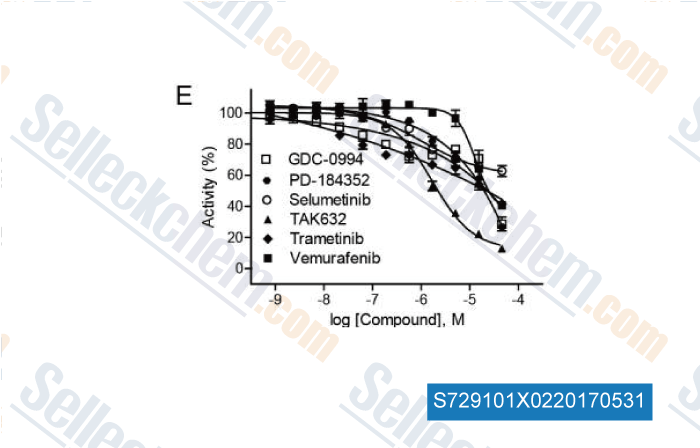|
Toll Free: (877) 796-6397 -- USA and Canada only -- |
Fax: +1-832-582-8590 Orders: +1-832-582-8158 |
Tech Support: +1-832-582-8158 Ext:3 Please provide your Order Number in the email. |
Technical Data
| Formula | C27H18F4N4O3S |
|||
| Molecular Weight | 554.52 | CAS No. | 1228591-30-7 | |
| Solubility (25°C)* | In vitro | DMSO | 100 mg/mL (180.33 mM) | |
| Ethanol | 2 mg/mL (3.6 mM) | |||
| Water | Insoluble | |||
|
* <1 mg/ml means slightly soluble or insoluble. * Please note that Selleck tests the solubility of all compounds in-house, and the actual solubility may differ slightly from published values. This is normal and is due to slight batch-to-batch variations. * Room temperature shipping (Stability testing shows this product can be shipped without any cooling measures.) |
||||
Preparing Stock Solutions
Biological Activity
| Description | TAK-632 is a potent pan-Raf inhibitor with IC50 of 8.3 nM and 1.4 nM for B-Raf(wt) and C-Raf in cell-free assays, respectively, showing less or no inhibition against other tested kinases. | |||||||||||
|---|---|---|---|---|---|---|---|---|---|---|---|---|
| Targets |
|
|||||||||||
| In vitro | TAK-632 inhibits phosphorylation of MEK and ERK in melanoma A375 cells (BRAFV600E) with IC50 of 12 nM and 16 nM, respectively. In human melanoma HMVII cells (NRASQ61K/BRAFG469V), TAK-632 also shows strong inhibition of pMEK and pERK with IC50 of 49 nM and 50 nM, respectively. Moreover, TAK-632 also exhibits antiproliferative activity in both A375 and HMVII cells with GI50 of 66 nM and 200 nM, respectively. [1] TAK-632 induces RAF dimerization but inhibits the kinase activity of the RAF dimer because of its slow dissociation from RAF. The combination of TAK-632 and TAK-733 exhibits synergistic antiproliferative effects in BRAF- and NRAS-mutated melanoma cells. [2] | |||||||||||
| In vivo | TAK-632 shows superior oral bioavailability in both rats and dogs. TAK-632 (3.9–24.1 mg/kg, p.o.) exhibits dose-dependent antitumor efficacy without severe body weight reduction in a melanoma A375 (BRAFV600E) xenograft model and a human melanoma HMVII (NRASQ61K/BRAFG469V) xenograft in rats. [1] In NRAS-mutant melanoma SK-MEL-2 xenograft model, TAK-632 (60 or 120 mg/kg, p.o.) also exhibits potent antitumor efficacy without severe toxicity. [2] | |||||||||||
| Features | Orally bioavailable, pan-raf inhibitor that targets both wild-type and mutant forms. |
Protocol (from reference)
| Kinase Assay: |
|
|---|---|
| Cell Assay: |
|
| Animal Study: |
|
References
|
Customer Product Validation

-
Data from [Data independently produced by , , Oncotarget, 2016, 7(7):8172-83]
Selleck's TAK-632 has been cited by 33 publications
| Cell-specific models reveal conformation-specific RAF inhibitor combinations that synergistically inhibit ERK signaling in pancreatic cancer cells [ Cell Rep, 2024, 43(9):114710] | PubMed: 39240715 |
| Hypoxia drives HIF2-dependent reversible macrophage cell cycle entry [ Cell Rep, 2024, 43(7):114471] | PubMed: 38996069 |
| HDAC Inhibition Restores Response to HER2-Targeted Therapy in Breast Cancer via PHLDA1 Induction [ Int J Mol Sci, 2023, 24(7)6228] | PubMed: 37047202 |
| A Combination of Conformation-Specific RAF Inhibitors Overcome Drug Resistance Brought about by RAF Overexpression [ Biomolecules, 2023, 13(8)1212] | PubMed: 37627277 |
| BRAFΔβ3-αC in-frame deletion mutants differ in their dimerization propensity, HSP90 dependence, and druggability [ Sci Adv, 2023, 9(35):eade7486] | PubMed: 37656784 |
| Systematic analysis of the MAPK signaling network reveals MAP3K-driven control of cell fate [ Cell Syst, 2022, 13(11):885-894.e4] | PubMed: 36356576 |
| Strategies to inhibit FGFR4 V550L-driven rhabdomyosarcoma [ Br J Cancer, 2022, 10.1038/s41416-022-01973-6] | PubMed: 36097178 |
| A Systems Biology Approach to Investigate Kinase Signal Transduction Networks That Are Involved in Triple Negative Breast Cancer Resistance to Cisplatin [ J Pers Med, 2022, 12-81277] | PubMed: 36013226 |
| Proteasomal down-regulation of the proapoptotic MST2 pathway contributes to BRAF inhibitor resistance in melanoma [ Life Sci Alliance, 2022, 5(10)e202201445] | PubMed: 36038253 |
| A systematic analysis of signaling reactivation and drug resistance [ Cell Rep, 2021, 35(8):109157] | PubMed: 34038718 |
RETURN POLICY
Selleck Chemical’s Unconditional Return Policy ensures a smooth online shopping experience for our customers. If you are in any way unsatisfied with your purchase, you may return any item(s) within 7 days of receiving it. In the event of product quality issues, either protocol related or product related problems, you may return any item(s) within 365 days from the original purchase date. Please follow the instructions below when returning products.
SHIPPING AND STORAGE
Selleck products are transported at room temperature. If you receive the product at room temperature, please rest assured, the Selleck Quality Inspection Department has conducted experiments to verify that the normal temperature placement of one month will not affect the biological activity of powder products. After collecting, please store the product according to the requirements described in the datasheet. Most Selleck products are stable under the recommended conditions.
NOT FOR HUMAN, VETERINARY DIAGNOSTIC OR THERAPEUTIC USE.
